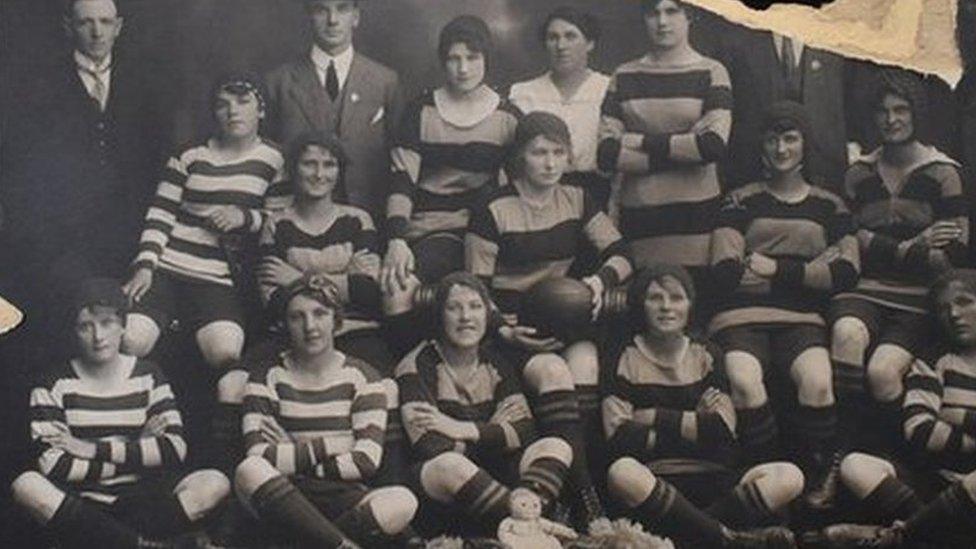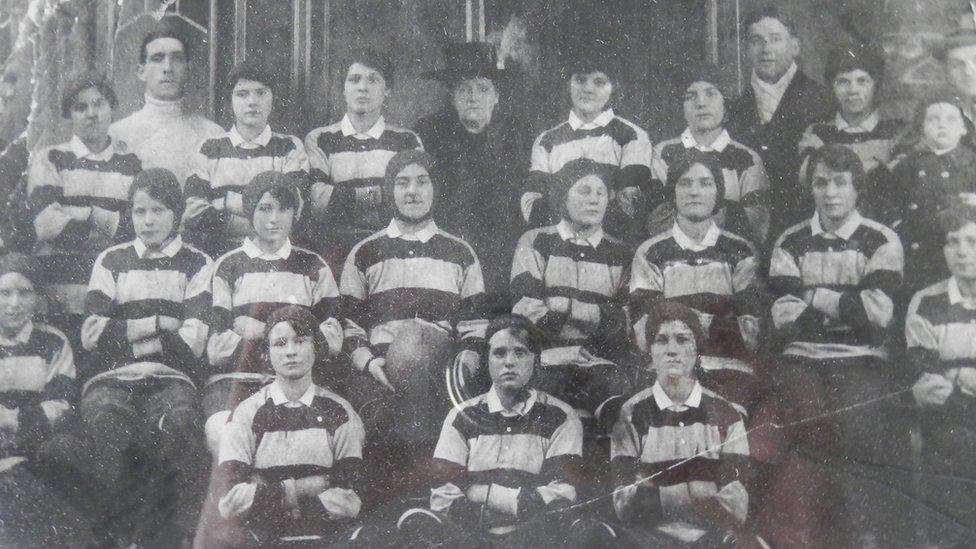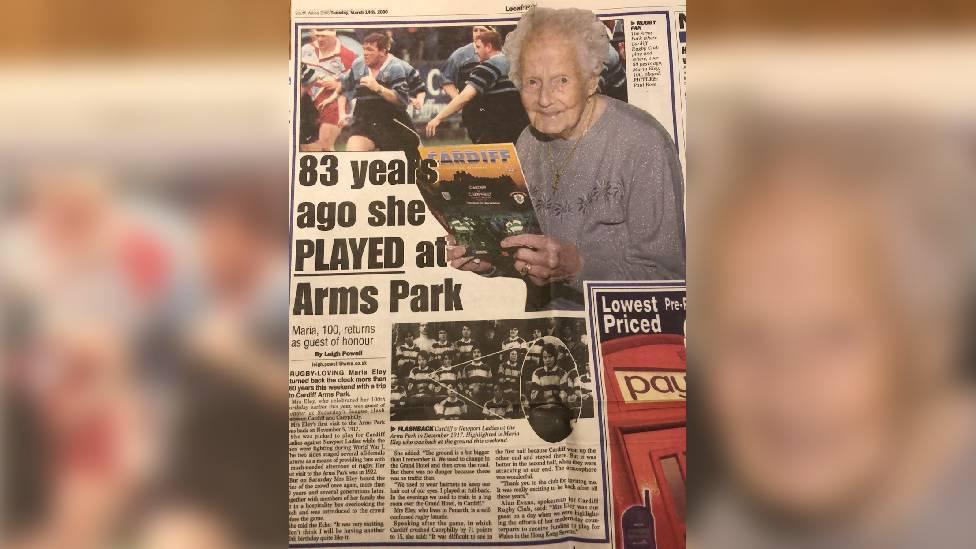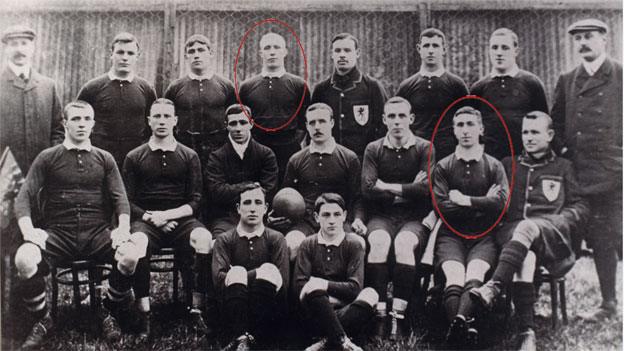Armistice Day: WW1 Wales women's radical rugby movement
- Published

The team from the National Cartridge and Box repairing factory in Newport
When men went to fight in World War One, women at a munitions factory in Newport formed rugby teams, inspiring a movement that "pushed boundaries".
They contributed to a fundraising effort for a submarine and raised millions in today's money.
But when the Armistice came, support disappeared until the 1970s.
A well-preserved photo shows the team from the National Cartridge and Box repairing factory in Newport.
A historian says the Welsh women led a movement of women's rugby that "pushed boundaries".
Lydia Furse, who works at the World Rugby Museum in Twickenham, says the photograph is "quite probably the oldest photograph of a women's rugby team in the world".
"People might have already heard how the First World War made a lot of changes in women's sport, and particularly with women's football in England," she said.
"But Wales is a rugby community and was during the First World War. It was rugby that the women wanted to play when they got that chance to step onto the pitch."
Ms Furse described the team as "incredibly popular during their time".
"Their exhibition matches drew thousands of spectators. Up to 10,000 people were recorded at one game in December 1917," she explained.
"So it's really important to recognise that there was this moment of pure enjoyment and real positive vibes about women playing rugby in 1917 and 1918."
All of the games were played as charity matches, raising money for local funds and the war effort.
In 1918, the team took part in a fundraising carnival in Barry, Vale of Glamorgan, which raised £100,000 - equivalent to £5.3m today - which was enough to buy a submarine for the war effort.
Ms Furse described the movement's nine months as "incredible", and not something to be forgotten.
However, when the war ended, the growing women's rugby movement also came to an abrupt end.
Ms Furse said it was attitudes in the 1920s which stopped them from starting a new season.
"It seems that the armistice did mark the end of this moment of women's rugby in south-east Wales," she said.
"The teams really did require that space of the men not being there, so that the pitches were empty. The spectators wanted rugby, but didn't have any men to play the rugby because they were all off fighting in the war.
"Women's rugby took a long time to re-grow those roots in Wales."
She added that the struggle women went through to play at the time was reflected in many sporting communities today.
"People are still having to push boundaries but, with a lot of hard work, it is happening. It's growing, and it would be amazing to see 10,000 people rocking up to see Newport v Cardiff in 2023.
"It's a really great opportunity to think about that family history, that local history, and maybe even inspire people to give rugby a try today. If my granny did it, why not me?"
Cardiff v Newport, 15 December 1917

The Cardiff women's squad from December 1917
The movement peaked when Newport played Cardiff in the Arms Park.
It was a game in aid of the Comforts Fund, for the men of the Cardiff City Battalion.
Newport won 6-0, or two tries under the old scoring system.
Maria Eley, 17, from Grangetown, Cardiff, was the fullback. She died in 2006, aged 106, and in an interview with Penarth Times the previous year, external, attributed her longevity to a love of rugby.
"We loved it," she said.

Maria Eley attributed her longevity to a love of rugby
"It was such fun with all of us together on the pitch, but we had to stop when the men came back from the war, which was a shame. Such great fun we had."
Maria's granddaughter, Adrienne Davey, said she was "extremely proud" of her grandmother, but it was only spoken about in the family after the turn of the century.
She said: "I didn't see the photograph until 15 years ago. It's just amazing seeing how young she was.
"She never really talked about it. She was always into sport. But she never spoke to me about rugby."
Newport v Newport, 29 September 1917
The Arms Park clash wasn't the first match there.
The Western Mail recorded a game between two teams from the Newport munitions factory.
The newspaper said "a wonderful display of scrimmaging, running, passing, and kicking was given by the girls, who pleased the spectators immensely by their vimful and earnest methods."
It added: "The match ended in a draw of one try each (3-3). The referee, Mr R Pollock, of Newport, stated that he had refereed many a worse game between male teams."
The Cardiff Rugby Museum say that at least four women's rugby matches were reported in south-east Wales during a short space of time, which shows there may have been "greater enthusiasm for women's rugby than has previously been realised".
After the movement, it would be 69 years until the first representative Welsh women's rugby team played an international match - against England.
By looking back on its roots, the museum hopes to show that Wales "always had an important part to play in the history of women's rugby".
Ms Furse added: "People didn't know about these players and people still don't know about these players.
"To know that they did something so radical and so cool, it just gives you a real insight into what people were getting up to during the First World War."

Tracing families
The World Rugby Museum is asking family members of the Newport teams to get in touch, external so it can uncover more about the lost history.
Teams from 17 November 1917 at Pill Athletic Grounds:
Mr J Hillman's XV (black and white): W Hicks; Laura Williams; T Dunn, F Caspey; A Bird; V Plaister; G Carbin; M Sprod (captain); S Sivenson; A Brady; L James; C Scott; L Percy; L Ginger; and L Brittle.
Mr J Trigg's XV (black and blue): K Hayward; G Clarke; P Cappelle; Alice Williams; R Cummings; R Harrison; N Danshir; H Hayward (captain); H Dermorty; M Marney; R Roach; L Francis; H Brian; W Wigmere; and M Collins.

- Attribution
- Published12 January 2022

- Published15 August 2014
